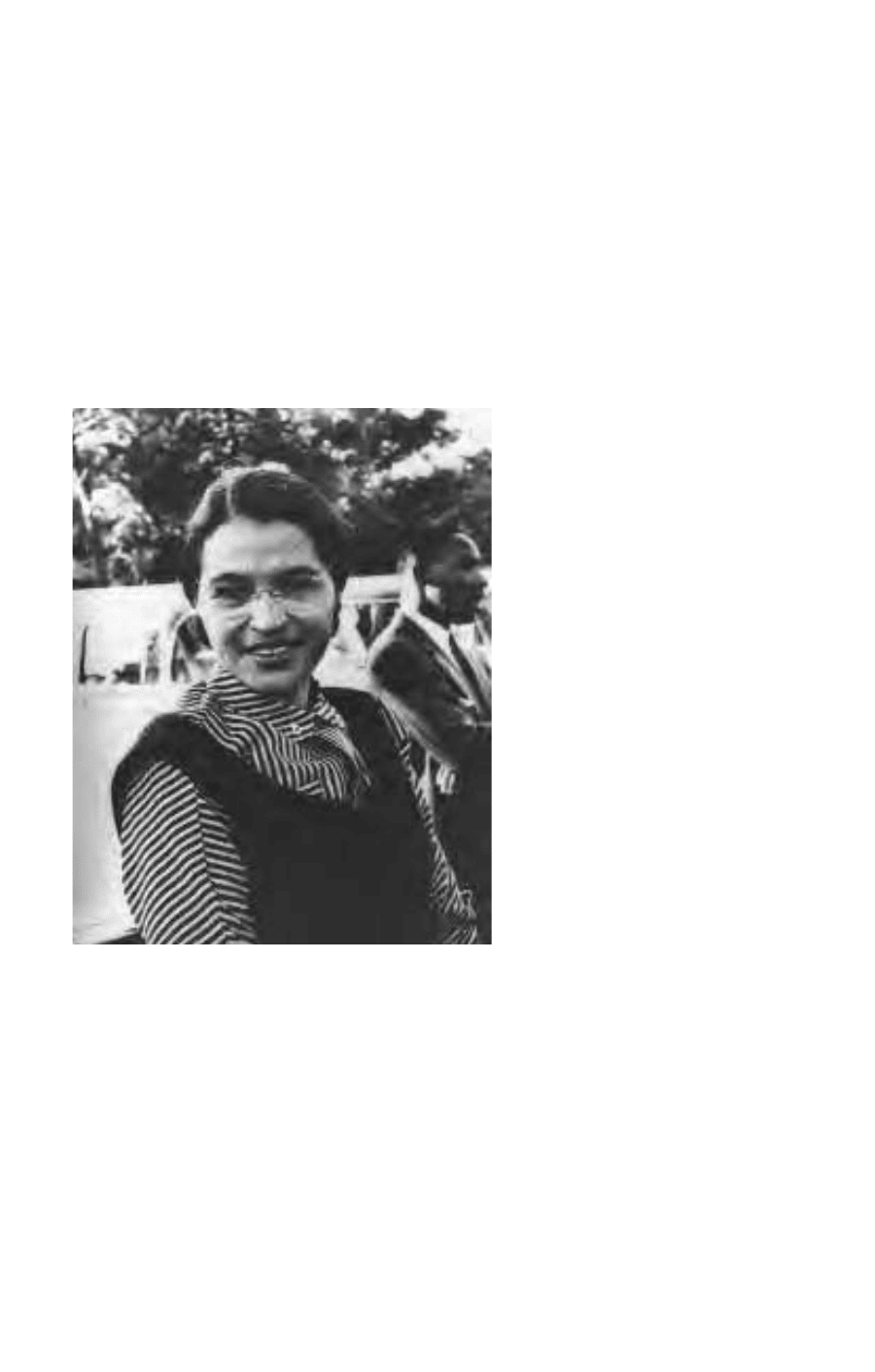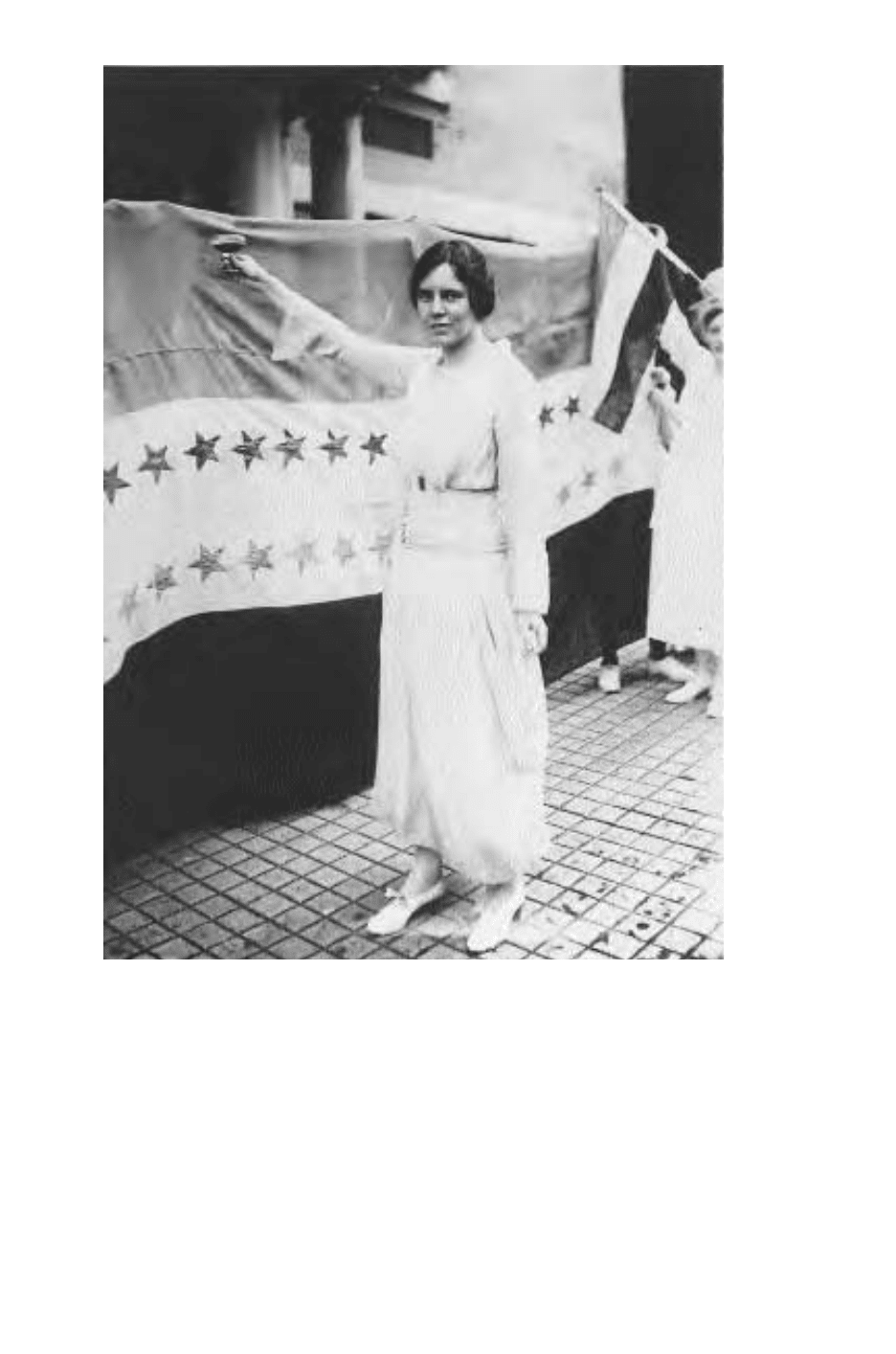Schenken Suzanne O’Dea. From Suffrage to the Senate: An Encyclopedia of American Women in Politics (2 Volumes)
Подождите немного. Документ загружается.


See also Governors, Women
References Mullaney, ed., Biographical Directory of the Governors of the United
States 1988–1994 (1994).
Orr v. Orr (1979)
Orr v. Orr challenged Alabama divorce laws that provided that husbands,
but not wives, may be required to pay alimony. The U.S. Supreme Court
wrote that “even statutes purportedly designed to compensate for and
ameliorate the effects of past discrimination must be carefully tailored.”
The Court found the Alabama statutes unconstitutional under the equal
protection clause of the Fourteenth Amendment.
See also Fourteenth Amendment
References Orr v. Orr, 440 U.S. 268 (1979).
Ortega, Katherine Davalos (b. 1934)
Appointed treasurer of the United States by President Ronald Reagan,
Hispanic American Katherine D. Ortega served from September 1983 to
June 1989. She first served in the Reagan administration as a member of
the Presidential Advisory Committee on Small and Minority Business
Ownership.
Born in Tularosa, New Mexico, Ortega earned her bachelor’s degree
at Eastern New Mexico State University in 1957. She became a certified
public accountant in 1979. Ortega worked in accounting and banking in
the 1960s and 1970s. In 1975, she became the first woman president of a
California bank.
References Telgen and Kamp, eds., Notable Hispanic American Women (1993).
Owen Rohde, Ruth Bryan (1885–1954)
Democrat Ruth Owen of Florida served in the U.S. House of Representa-
tives from 15 April 1929 to 4 March 1933. The daughter of William Jen-
nings Bryan, who had run for president three times and who was
renowned for his oratory, Owen shared her father’s oratorical skills. In the
1920s she was a professional lecturer with the Chautauqua, which traveled
the country offering education and entertainment. Her abilities as a
speaker helped her win a congressional seat in 1928 after a failed attempt
for Congress in 1926. Her opponent, however, challenged her success by
claiming that her citizenship status was uncertain. Owen had married a
British subject in 1910, and under the laws of the time, she had forfeited
her U.S. citizenship. The Cable Act of 1922 had given women independ-
ent citizenship, but legal technicalities left her citizenship in doubt. The
Owen Rohde, Ruth Bryan 519

Elections Committee, however, decided in her favor. As a member of Con-
gress, Owen clarified married women’s status as citizens by amending the
Cable Act, one of her most significant achievements in Congress. The first
woman since Jeannette Rankin (R-MT) to work for women’s issues, Owen
proposed the creation of a federal Department of Home and Child and
supported the creation of a mothers’ pension.
Owen sought to make the Everglades a national park and worked for
other conservation and wildlife preservation issues. She also supported
Prohibition, a position that likely contributed to her defeat in the 1932
primary election. President Franklin Roosevelt appointed her to head a
U.S. diplomatic mission to Denmark in 1933, making her the first woman
to hold the position of envoy extraordinary and minister plenipotentiary.
She resigned in 1936 after marrying a Danish citizen. She held other ap-
pointments in the State Department and to the United Nations.
Born in Jacksonville, Illinois, Owen lived in Jamaica, West Indies,
from 1910 to 1912 and in London, England, from 1912 to 1915. A war
nurse in the Voluntary Aid Detachment in the Egypt-Palestine campaign
from 1915 to 1918, she returned to the United States in 1919. She lectured
regularly on the Chautauqua and Lyceum series from 1918 to 1928 and
was a member of the University of Miami faculty from 1926 to 1928.
See also Cable Acts; Congress, Women in
References Breckenridge, Women in the Twentieth Century (1933); H. W.
Wilson, Current Biography: Who’s News and Why, 1944 (1944); Tolchin,
Women in Congress: 1917–1976 (1976).
520 Owen Rohde, Ruth Bryan

Park, Maud Wood (1871–1955)
First president of the League of Women Voters, Maud Wood Park led the
congressional lobbying effort of the National American Woman Suffrage
Association (NAWSA) from 1917 to 1919. As chair of NAWSA’s Congres-
sional Committee, Park’s task was to obtain congressional approval of the
woman suffrage amendment. She trained volunteers who visited Wash-
ington, D.C., to lobby their congressional representatives, coordinated
the lobbying effort, managed an extensive set of biographical and per-
sonal information about each member of Congress, and developed
strategies for the amendment’s passage. Because the United States had
entered World War I and Congress had decided to debate only war-
related measures, Parks sought to have a special committee on woman
suffrage created as a way to circumvent the limit. Using social contacts
and the political network she had developed, Parks got her committee,
which favorably reported a woman suffrage amendment. The U.S. House
of Representatives approved it in 1918, but the Senate did not approve it
that session. In 1919 both chambers passed the amendment, and it was
ratified in 1920.
In 1919, Park agreed to accept the presidency of the League of Women
Voters (LWV), the organization that NAWSA president Carrie Chapman
Catt had proposed to succeed NAWSA. Park traveled the country lecturing
and recruiting members for the league, helped develop its legislative
agenda, and led the organization during its formative years, serving as
president from 1920 to 1924. In addition to her league responsibilities,
521
P

Park helped organize and was head of the Women’s Joint Congressional
Committee, a lobbying coalition that passed the Sheppard-Towner Ma-
ternity and Infancy Protection Act of 1921 and the Cable Act of 1922.
Born in Boston, Massachusetts, Park graduated from Radcliffe Col-
lege in 1898.
See also Cable Acts; Catt, Carrie Clinton Lane Chapman; League of Women
Voters; National American Woman Suffrage Association; Nineteenth
Amendment; Sheppard-Towner Maternity and Infancy Protection Act of 1921;
Suffrage; Women’s Joint Congressional Committee
References Park, The Front Door Lobby (1960); Sicherman and Green, eds.,
Notable American Women: The Modern Period (1980).
Parks, Rosa Louise McCauley
(b. 1913)
Called “the first lady of civil rights”and “the
mother of the freedom movement,” Rosa
Parks helped launch the modern civil rights
movement in the 1950s by refusing to relin-
quish her seat on a Montgomery, Alabama,
city bus to a white man. Her refusal to com-
ply with the city’s bus segregation laws pro-
vided a catalyst for a bus boycott that lasted
381 days and a U.S. Supreme Court deci-
sion that bus segregation was illegal.
Parks’s visible work in civil rights be-
gan in 1943, when she became secretary of
the Montgomery affiliate of the National
Association for the Advancement of Col-
ored People (NAACP). She attempted to
register to vote in 1943, but her applica-
tion was denied, as it was in 1944. She re-
ceived her certificate to vote in 1945. In addition to her NAACP work,
Parks belonged to the Montgomery (Alabama) Voters League, and in the
summer of 1955 she had attended civil rights workshops. Acutely aware of
segregation and offended by it, she avoided using segregated facilities
whenever she could.
On 1 December 1955, she was riding home from her job as an assis-
tant tailor and was seated in the first row of seats designated for blacks.
When the white section filled and another white rider got on the bus, the
bus driver asked the four black people sitting in that first row of the black
section to move to give the seat to the white man. Three of them submit-
ted. Parks refused. She later recollected:
522 Parks, Rosa Louise McCauley
Rosa Parks, the woman
who sparked the civil
rights movement for
refusing to give up
her seat on a bus in
Montgomery, Alabama,
in 1955, received the
Congressional Medal
of Honor in 1999
(Courtesy: National
Archives)

After so many years of oppression and being a victim of the
mistreatment that my people suffered, not giving up my seat—
and whatever I had to face after not giving it up—was not im-
portant. I did not feel any fear at sitting in the seat I was sitting
in. All I felt was tired. Tired of being pushed around....Tired
of the Jim Crow laws. Tired of being oppressed. I was just plain
tired.
Arrested, jailed, convicted, and fined $10, Parks refused to pay the fine and
appealed her case.
The Women’s Political Council, a local civil rights organization, had
been looking for an opportunity to challenge bus segregation, and Parks’s
arrest provided the opportunity. On 2 December, the council distributed
more than 52,000 flyers calling for a one-day bus boycott on the day of
Parks’s trial. More than 7,000 African Americans responded by gathering
at the Holt Street Baptist Church, which led to the formation of the Mont-
gomery Improvement Association, the group that helped launch Martin
Luther King, Jr.’s national leadership. The bus boycott that followed
helped galvanize the civil rights movement and ended when the U.S.
Supreme Court upheld a lower court decision that segregated bus seating
was unconstitutional.
By that time, Parks had lost her job, but she has said that she had no
proof that she lost her job because of the boycott. She moved to Detroit,
remained involved in the civil rights movement, and continued to support
herself by working as a seamstress. In 1965, she joined Congressman John
Conyers’s staff.
Born in Tuskegee, Alabama, Rosa Parks left high school to care for
her seriously ill mother and worked as a housekeeper and a seamstress.
She received her high school diploma in 1934. She wrote her autobiogra-
phy, Rosa Parks: My Story, in 1992. She continues to speak around the
country and to raise money for the National Association for the Advance-
ment of Colored People.
See also Civil Rights Movement, Women in the; National Association for the
Advancement of Colored People, Women in the
References H. W. Wilson, Current Biography Yearbook, 1989 (1989); Parks, Quiet
Strength (1994).
Patterson, Elizabeth Johnston (b. 1939)
Democrat Elizabeth Patterson of South Carolina served in the U.S. House
of Representatives from 3 January 1987 to 3 January 1993. Patterson’s po-
litical experience began when she was a young girl working on her father
Olin D. Johnston’s campaign for the U.S. Senate in 1945 and continued
through 1965. Patterson’s first political office was on the Spartanburg
Patterson, Elizabeth Johnston 523

County Council, where she served from 1975 to 1976. She then served in
the South Carolina Senate from 1979 to 1986.
A fiscal conservative, Patterson worked to reduce the federal budget
deficit, supported a constitutional amendment to ban desecration of the
American flag, worked for veterans’ concerns, and opposed the Family and
Medical Leave Act of 1993. She chaired the Congressional Textile Caucus
and the Conservative Democratic Forum’s Budget Reform Task Force. De-
feated in 1992, she became director of continuing education for Converse
College and an adjunct professor at Spartanburg Methodist College.
Born in Columbia, South Carolina, Patterson graduated from Co-
lumbia College in 1961 and attended graduate school at the University of
South Carolina for a year. She worked for the Peace Corps from 1962 to
1964 and for VISTA from 1965 to 1967, was a Head Start coordinator
from 1967 to 1968, and held a job as a congressional staff assistant from
1969 to 1970.
See also Congress, Women in; Family and Medical Leave Act of 1993; State
Legislatures, Women in
References Congressional Quarterly, Politics in America 1992 (1991); Office of
the Historian, U.S. House of Representatives, Women in Congress, 1917–1990
(1991).
Paul, Alice (1885–1977)
American militant suffrage leader Alice Paul introduced controversial and
confrontational strategies to the U.S. campaign for woman suffrage,
founded the National Woman’s Party, and proposed the first Equal Rights
Amendment. She began her political activism in England and Scotland,
where she lived from 1907 to 1910, working with mother-and-daughter
British suffragists Emmeline and Christabel Pankhurst. From them, she
learned the strategies that characterized her efforts in the U.S. woman suf-
frage campaign, including the use of civil disobedience to generate pub-
licity for a cause. Arrested seven times and jailed three times for her suf-
frage activities, she went on hunger strikes each time she was incarcerated.
During one of the hunger strikes, officials force-fed her using a nasal tube
twice a day for four weeks, a painful and bloody process.
When Paul returned to the United States in 1910, she joined the Na-
tional American Woman Suffrage Association (NAWSA). From the time
that Paul became involved in the U.S. suffrage movement, she and
NAWSA’s leaders differed in their perceptions of effective strategies to pass
the woman suffrage amendment. NAWSA focused on passing state con-
stitutional amendments and placed less emphasis on its Congressional
Committee, a group that was allotted a budget of only $10 a year. NAWSA
was successful in gaining the introduction of the amendment every ses-
524 Paul, Alice

sion but was unable to move it out of committee. In addition, NAWSA
leaders resisted public demonstrations, believing in a more reserved ap-
proach. Paul believed that state campaigns would take too long and were
an inefficient use of resources. She firmly believed in a federal amendment
and organized demonstrations, parades, and other events to attract pub-
licity and place the amendment before the public.
In 1912, Paul accepted the chair of NAWSA’s Congressional Com-
mittee with the understanding that NAWSA would not allocate any funds
to the committee. She planned a massive suffrage parade in Washington,
D.C., raised funds to pay for it, and invited women across the country to
Paul, Alice 525
Alice Paul, radical
leader of the
National Woman’s
Party and tireless
advocate of the Equal
Rights Amendment,
1920 (Library of
Congress)

participate. She scheduled the event for 3 March 1913, the day President-
elect Woodrow Wilson was to arrive in the city and the day before his in-
auguration. Twenty-six floats, ten bands, five squadrons of cavalry, six
chariots, and approximately 8,000 women marched by 500,000 spectators,
who chose to watch the suffragists instead of Wilson’s arrival in the city.
When the crowd became unruly and moved into the parade route, the po-
lice did not protect the marchers, and 200 people were treated for injuries.
Press coverage of the parade and the subsequent Senate investigation of
the police superintendent renewed interest in the Congressional Commit-
tee and the amendment.
A month after the parade, conflicts between Paul and NAWSA devel-
oped over money. Paul’s success raising money led some NAWSA leaders
to suggest that Paul should give some of it to the larger organization be-
cause they felt that donors were confused about which group they had
contributed to. Paul solved the problem by creating the Congressional
Union (CU), a separate organization that was affiliated with NAWSA, to
raise money for the Congressional Committee’s projects. She continued to
chair the Congressional Committee, and conflict persisted. Late in 1913,
NAWSA leaders told Paul she could chair the Congressional Committee
or the CU but not both. Paul chose the Congressional Union. Because
NAWSA president Anna Howard Shaw viewed the CU as a threat to her
organization, the CU was not permitted to remain a NAWSA auxiliary. In
1914, Paul left NAWSA and continued to lead the CU.
Paul had brought the idea of marches and parades to the United
States from her experience in England. She also used the British suffragists’
strategy of placing responsibility on the political party in power, regardless
of individual members’ support for suffrage. By organizing women voters
in suffrage states to oppose Democratic candidates in the 1914 elections,
she made suffrage an issue in several states. The CU took credit for defeat-
ing five Democrats and contributing to the defeat of twenty-three more.
In 1916, Paul formed the Woman’s Party and repeated the strategy.
As the United States prepared to enter World War I, Paul and her fol-
lowers remained steadfast in their focus on suffrage. Although many suf-
fragists opposed the war, only Paul supported Wyoming congresswoman
Jeannette Rankin’s vote against declaring war. Early in 1917, Paul and her
followers started picketing outside the White House. After several months,
police began to arrest the pickets for obstructing traffic but would then re-
lease them. As the pickets continued, they were arrested, tried, found guilty,
and fined. Those who refused to pay the fines were jailed for a few days.
When Paul was arrested in an October 1917 demonstration, however, she
was sentenced to seven months at a women’s prison, where she went on a
hunger strike. Force-fed, she was separated from other prisoners and
526 Paul, Alice

placed in a psychiatric ward and denied visitors, mail, and messages.
Protests over her treatment led to her release within a month.
The Nineteenth Amendment granting woman suffrage became part
of the U.S. Constitution on 26 August 1920. Paul’s contributions to the
suffrage campaign include attracting publicity to the amendment through
the marches, parades, and pickets she organized and by making the
amendment an issue in the 1914 and 1916 elections. President of NAWSA
Carrie Chapman Catt, however, has generally received primary credit for
the amendment’s passage in Congress and its ratification by the states,
with Paul’s role receiving considerably less attention.
In 1921, Paul transformed the Woman’s Party into the National
Woman’s Party (NWP), which had as its sole purpose the passage and rat-
ification of a federal equal rights amendment. Sometimes referred to as
the Lucretia Mott Amendment, it read: “Men and women shall have equal
rights throughout the United States and every place subject to its jurisdic-
tion.” Initially, the amendment was opposed by virtually every women’s
organization in the country. Paul and the NWP, however, worked for the
amendment for the next fifty years. They succeeded in getting the amend-
ment introduced in every session of Congress beginning in 1923. When
Congress passed the amendment in 1972, it was the result of work done
by the modern feminist movement. Paul worked for its ratification until
1974, when ill health prevented her from continuing. The amendment
failed because it was three states short of the thirty-eight needed for rati-
fication when the final deadline arrived in 1982.
Paul also worked on the international level. She led the creation of
the World Woman’s Party in 1938 and served as its founding president. In-
tended to unite American, Asian, and European feminists, the potential
for the World Woman’s Party was lost when World II began. She later
fought for the inclusion of sex equality in the preamble to the United Na-
tions Charter. In 1977, Paul said:“The thing I think that was the most use-
ful I ever did was having a part in getting the vote for all the women, be-
cause that was a big transformation for the country to have one-half the
country enfranchised.”
Born in Moorestown, New Jersey, Alice Paul graduated from Swarth-
more College in 1905 and earned her master of arts degree in 1907 and
her doctoral degree in 1912, both from the University of Pennsylvania.
She also held three law degrees.
See also Catt, Carrie Clinton Lane Chapman; Congressional Union; Equal
Rights Amendment; National American Woman Suffrage Association; National
Consumers League; National Woman’s Party; Nineteenth Amendment; Protec-
tive Legislation; Rankin, Jeannette Pickering; Shaw, Anna Howard; Suffrage;
Women’s Bureau; Women’s Trade Union League
Paul, Alice 527

References Lunardini, From Equal Suffrage to Equal Rights: Alice Paul and the
National Woman’s Party (1986); New York Times, 4 November 1975, 10 January
1977.
Pay Equity
Pay equity, sometimes called “comparable worth” or “fair pay,” is a method
for determining wages so as to overcome traditional gender and racial bi-
ases that result, on average, in female workers earning less than male
workers and minority workers earning less than white workers. The wage
gap for women has ranged from 56.6 percent of men’s earnings in 1973 to
73.8 percent in 1996, although there has not been a steady increase. In
1997, white women earned about 75 percent of men’s earnings, African
American women earned about 67 percent, Asian American women
earned about 80 percent, and Latinas earned about 58 percent. In a 1994
survey conducted by the Women’s Bureau, over a quarter of a million U.S.
women said that their top priority was “improving pay scales.”
Following the passage of the 1963 Equal Pay Act, many thought that
the differences between women’s and men’s pay would significantly di-
minish. When it became clear that the act would not close the wage gap,
other reasons for its persistence were examined. Pay discrimination con-
tinues despite state and federal policies against it, and women tend to
work in traditionally undervalued jobs and cluster in a few job categories:
clerical, teaching, service work, and nursing. The more that an occupation
is dominated by women or people of color, the greater the wage gap be-
tween people in that occupation and men in general.
One approach used to achieve pay equity is comparable worth, a
method for evaluating jobs that uses a point system to rate the skill, effort,
responsibility, and working conditions of each job; totals the points; and
establishes the job’s relative worth. Seniority, merit, quantity of work, and
quality of work continue to differentiate individuals’ wages within equiv-
alent job classifications. Some states and municipalities have implemented
comparable worth programs, even though the approach has not received
support at the federal level. The Equal Employment Opportunity Com-
mission concluded that Congress had not authorized it to implement
comparable worth programs, and the courts have not made a definitive
decision on the issue.
In the 1990s, pay equity or fair pay proposals gained renewed vitality
as groups supporting the issue began to identify pay equity as a working
family issue instead of exclusively a women’s issue. Several organizations
made pay equity a legislative priority, including the Coalition of Labor
Union Women, National Committee on Pay Equity, and American Feder-
ation of Labor–Congress of Industrial Organizations. In addition, the
528 Pay Equity
